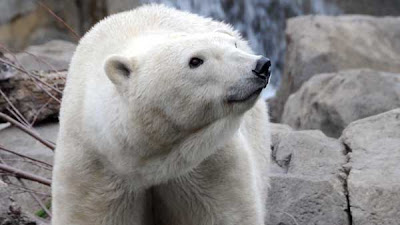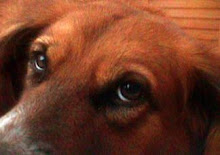 Polar Bear 20741 swam 427 miles in 9 days/(this is not the bear of the story in this photo / Arctic Bear Productions)
Polar Bear 20741 swam 427 miles in 9 days/(this is not the bear of the story in this photo / Arctic Bear Productions) Eisbärin schwimmt 687 Kilometer am Stück
Eisbären gelten als hervorragende Schwimmer. Völlig zu Recht, haben amerikanische Forscher erstmals belegen können. Ein Weibchen, das sie mit einem Sender versehen hatten, schwamm neun Tage lang ohne Pause und legte dabei eine Strecke von 687 Kilometern zurück.
“Diese Fähigkeit könnte dem Eisbär helfen, mit dem Rückgang des arktischen Meereises zurechtzukommen”, erklären George Durner vom US Geological Survey und seine Kollegen. Die Ausdauerleistung habe dem Weibchen allerdings einen hohen Preis abverlangt, berichten die Forscher im Fachblatt “Polar Biology”. Das Tier habe nicht nur viel Körpermasse verloren, sondern auch sein Junges.
Eisbären (Ursus maritimus) ernähren sich beinahe ausschließlich von Robben, die sie von der Meereisdecke aus jagen. Die Fläche insbesondere des alten, mehrjährigen Eises auf dem Nordpolarmeer hat sich in den letzten Jahrzehnten jedoch halbiert. Um mehr über die Konsequenzen zu erfahren, statteten Durner und Kollegen mehrere Tiere mit GPS-Sendern und mit Sensoren aus, die laufend die Temperatur in der Umgebung und unter der Haut maßen.
Das extrem ausdauernde Weibchen war im August 2008 in der Beaufortsee vor Alaska bzw. Kanada gefangen und mit Sender und Sensoren versehen worden, der Wiederfang erfolgte zwei Monate später. Die Auswertung der zwischenzeitlich gesammelten Daten ergab, dass das Tier zusätzlich zu seiner Marathon-Schwimmleistung eine Strecke von 1.800 Kilometern mal auf der Eisdecke, mal im Wasser zurückgelegt hatte. Seine Körpermasse nahm in dieser Zeit um mehr als ein Fünftel ab.
Dem Nutzen der großen Ausdauer angesichts der schwindenden Eisdecke stehen also hohe energetische Kosten und ein verminderter Fortpflanzungserfolg gegenüber, folgern Durner und seine Kollegen. Unter den harschen Bedingungen der Antarktis schafft es ohnehin nur die Hälfte des Eisbären-Nachwuchses bis zur Geschlechtsreife.
Forschung: George M. Durner, Steven C. Amstrup und Merav Ben-David, Alaska Science Center, US Geological Survey, Anchorage, und Department of Zoology and Physiology, University of Wyoming, Laramie; und andere.
Veröffentlichung Polar Biology, DOI 10.1007/s00300-010-0953-2
A skinny polar bear (not the one described in the story) that hauled itself onto a passing floe after being observed swimming in the open water off the coast of Alaska, far from the ice edge/ text & photo: Kieran Mulvaney Polar bear swims for 9 days , pays heavy price..."Researchers in Alaska have tracked a female polar bear swimming for 232 consecutive hours, during which time she covered 687 kilometers (427 miles) until she finally reached the sea ice of the Arctic Ocean. The finding underlines the enormous capacity of pola r bears to survive in the water, but also demonstrates the immense cost to them of having to do so for long periods. By the end of the ordeal, the bear had lost 22 percent of her body mass, and her yearling cub had apparently died.
r bears to survive in the water, but also demonstrates the immense cost to them of having to do so for long periods. By the end of the ordeal, the bear had lost 22 percent of her body mass, and her yearling cub had apparently died.
Writing in the journal Polar Biology, George Durner of the United States Geological Survey and colleagues describe capturing an adult female bear and her cub on Alaska's Beaufort Sea coast in late August 2008. Around the adult's neck, the researchers placed a radio collar with GPS unit, satellite uplink, and an accelerometer to monitor the bear's activity rate independent of the GPS measurements. (She was one of 13 bears so equipped by the researchers that month.)
The bear weighed 226 kg (498 lbs), and the yearling weighed 159 kg (350 lbs). When the scientists found the bear again, two months later, she weighed just 177 kg (390 lbs) and was not lactating; the yearling was nowhere to be seen.
By analyzing the recovered data and overlaying the bear's movements with ice charts, Durner and colleagues deduced that on 25 August (two days after capture and release) she entered the water off the Beaufort Sea coast and swam north for nine days, before finally reaching sea ice. She then spent three days on the ice, another day swimming, and a further 49 days on the sea ice before being found again.
The researchers write that although polar bears are marine mammals, in that they derive their nutrition from the ocean (i.e. they eat seals), they are not aquatic mammals. They can swim reasonably well and survive for long periods in the water, but they pay a high energetic cost for doing so. (Durner and colleagues were unable to determine whether this particular bear had recovered some of her weight by eating seals after hauling out on to the ice, or whether her condition had continued to deteriorate, perhaps as a consequence of patrolling an area of ice that was not rich in hunting opportunities.)
The question might reasonably be asked: Why did the bear keep swimming? Why didn't she at some point turn around? The answer seems to be that, simply, late August is the period when polar bears in northern Alaska head north on to the sea ice, and that is what she was doing. It is what polar bears are programmed to do, and there is nothing in their mental toolkit that would lead them to believe that ice wouldn't be just around the figurative corner, as long as they headed in the right direction.
Which, for the great majority of the time that polar bears have been polar bears, has been a reasonable assumption. But in 2008, Arctic sea ice extent was the second-lowest on record, with losses particularly acute in the Beaufort Sea. At the time this bear and her cub took their plunge, the ice was well over 500 km (320 miles) north of the Alaska coast.
As Arctic sea ice continues to decline, situations such as that confronted by this female bear could become more common, with even more severe consequences, an observation previously made in a 2006 paper in Polar Biology. In that paper, Charles Monnett and Jeffrey Gleason reported that, during aerial observations from 1987 to 2003, they saw 315 polar bears, of which just 12 were in open water. All 315 bears were alive. But in 2004, they saw 55 bears, of which 51 were alive. Ten of those 51 were found in open water, as were all four of the dead bears. And while it could not be proven that those four bears had drowned, it could reasonably be inferred that they had died in the water.
Monnett and Gleason speculated that "mortalities due to offshore swimming during late-ice (or mild ice) years may be an important and unaccounted source of natural mortality," and suggested that "drowning-related deaths of polar bears may increase in the future if the observed trend of regression of pack ice and/or longer open water periods continues."
Shell Werbekampagne 2010/see ad here
Im Zusammenhang mit dieser Geschichte steht auch ein Aufruf, sich dafür einzusetzen, dass Shell's Vorhaben in der Arktis von Alaska nach Öl zu bohren, gestoppt wird. Und es gibt gute Nachrichten, denn am 3. Februar scheint Shell sein Vorhaben, bereits in diesem Sommer mit Bohrungen dort zu beginnen, nun zum 3. Mal hat aufs Eis legen müssen...
In the context of this story I got appeals to help stopping Shell to start with petrol drilling in Alaska. But at least since February 3 there is good news for the time being...
"Polar bears and other imperiled Arctic species got a reprieve today with Royal Dutch Shell's announcement that it will not go forward with plans this summer to drill in critical habitat for the polar bear in Alaska. Shell's drilling plans off the coast of the Arctic National Wildlife Refuge have long been opposed by conservationists and native communities along the Alaska coast.
"The polar bear and other wildlife of Alaska's Arctic, as well as the local communities that depend upon a healthy ocean, were granted a well-deserved reprieve today," said Brendan Cummings, senior counsel at the Center for Biological Diversity. "Now, the Department of the Interior needs to turn that short-term reprieve into permanent protection of America's Arctic."
Today's announcement marks the third time that Shell's plans to drill in the Beaufort Sea have been put on hold in recent years. Drilling in 2007 and subsequent years was stopped by a federal court, which overturned the Interior Department's approval of Shell's exploration plan due to poor environmental review. Plans to drill in 2010 were suspended by Interior following the Deepwater Horizon disaster in the Gulf of Mexico. Shell's 2011 plan were put in doubt by an Environmental Protection Agency appeals-board decision overturning a necessary air permit, as well as the recent designation of polar bear critical habitat in the drilling area.
Oil development in the Arctic remains a dangerous proposition because no technologies exist to clean up oil spills in icy waters.
"Rather than revisiting the decision year after year on whether Shell and others can drill in the Arctic, the Department of the Interior needs to acknowledge the reality that it is impossible to clean up an oil spill in the Arctic, and simply pull this region off the table permanently for oil development," said Cummings.
Shell also has plans to drill in the adjacent Chukchi Sea next year. The Chukchi is also critical habitat for polar bears, as well as home to the Pacific walrus. Interior is scheduled to announce in the coming days whether walrus should also be listed under the Endangered Species Act."
Source:
- Eisbärin schwimmt 687 km am Stück/Scienceticker Umwelt 25.01.2011
- Polar Bear swims for 9 days,pays heavy price /Disvovery news - Kieran Mulvaney 26.01.2011 - Polar Bear's long swim illustrate ice melt/ Los Angeles Times - Kim Murphy 29.01.2011
- Researchers witness polar bear's epic search for ice/ red orbit 26.01.2011
- GPS tracks 9-day polar bear's swim/GPS Tracking News 09.02.2011
- Polar Bear Swim covers 426 miles/Juneau Blogger.com 05.02.2011Related to Shell's drilling plans & lobbying campaingn in the Arctic:- Future plans for offshore drilling in the ractic could prove to be disastrous/Defenders of Wildlife 17.06.2010
- Don't be fooled by Shell's Arctic ads/Greenwash 15.11.2010
- Shell presses for Drilling in Arctic/ The New York Times 05.11.2010
- Shell halts plans to Drill in Heart of Polar Bear's Alaska Habitat/Yuba Net.com /Center for Biological Diversity 03.02.2011
 Photo: Barbara Scheer
Photo: Barbara Scheer Photo: Barbara Scheer
Photo: Barbara Scheer Photo: Barbara Scheer
Photo: Barbara Scheer ...))
...)) Vorwitzige Augen hat Uli auch... Hier mal ein Foto aus der Presse...
Vorwitzige Augen hat Uli auch... Hier mal ein Foto aus der Presse...
 Mehr Uli, Shawu und die anderen hier bei Barbara Scheer - More Uli , Shawu & the others
Mehr Uli, Shawu und die anderen hier bei Barbara Scheer - More Uli , Shawu & the others
































































